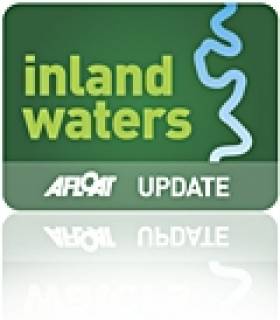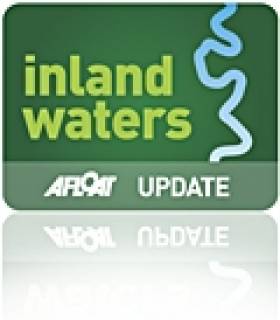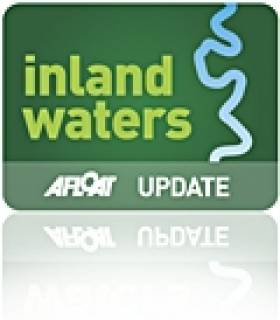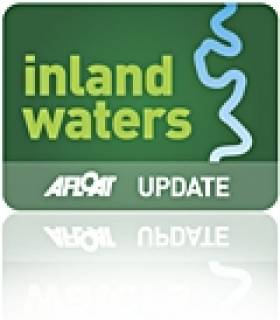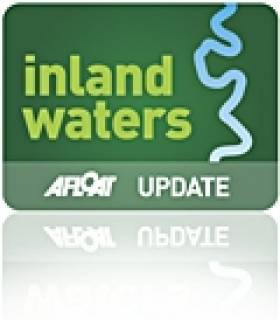Displaying items by tag: Inland
Waterways Ireland Welcomes European Strategic Partners
Waterways Ireland is facilitating Masterclasses in Dublin and Enniskillen from the 14-15 September 2011 for the 17 EU partners involved in the Waterways Forward INTERREG IVC Project. The Waterways Forward project is focused on the 'enhancement of the management and the boosting of socio-economic development of regional inland waterways and their adjacent waterways' right across Europe.
The Masterclasses will address issues around the sustainable development of inland waterways and the potential impact of climate change on regional inland waterways across Europe. Welcoming the partners to Dublin in advance of the Masterclasses, Waterways Ireland Chief Executive, John Martin stated;
"The INTERREG IVC Project has recognised the unexploited economic resource of regional inland waterways in Europe and the potential contribution that they make to tourism development, economic growth and quality of life. Waterways Ireland is delighted to be a partner in this innovative project. I welcome our 16 partners not only to engage with them in the strategic work of the Masterclasses in developing the way forward for Europe's regional waterways but intend to also share with them the unique attributes of Ireland's inland waterways"
Lead by the Dutch Recreational Waterways Foundation, the INTERREG IVC Project runs from January 2010 to December 2012 and has a total budget of just over €2.8 million. The Masterclasses are one of a series of meetings, conferences and research projects being undertaken by the partners with the aim of sharing best practice, developing integrated, tailor made governance structures & models and facilitating increased cooperation at EU level.
A truly amazing gathering will take place this weekend in the historic town of Inistioge. It is unlikely that circumstances will conspire to facilitate a similar event for many years, so this is definitely a weekend 'not to be missed'. Heritage cargo boats will sail up the Nore valley on a rising tide from New Ross as they did for hundreds of years before the road and rail networks made them redundant. Their destination is Inistioge, the venue for the Inistioge Vintage Rally, and it is here that the boats will rub shoulders, or should that be wheels and fenders, with the mighty machines at the Vintage Rally.
The Irish Vintage Society (IVS), the Heritage Boat Association (HBA) and the Inland Waterways Association of Ireland (IWAI) confirmed today that a combined gathering of vintage cars, heritage boats and other boats will take place in Inistioge over the weekend commencing Saturday July 30th. HBA and IWAI boats will arrive in the morning and the vintage cars in the early evening. John Madden, President of the IVS, will escort the cars through the village at 18:30 with his bagpipes.
On Sunday, starting at 10.00 vintage cars, tractors, oil engines and mills will be on display with live music and dancing and a selection of stalls. Presentation of the Leslie Rothwell Trophy for the Best Vintage Exhibit will take place. Children's activities will include the Duck Derby on the canal and the ever popular Dog Show. Down by the river on both Sunday and Monday there will be the opportunity to view the history of the heritage boats and the site for the proposed Inistioge Moorings.
The HBA's Three Sister Fleet is celebrating the 220th anniversary of the Barrow Navigation, which when first created linked the Grand Canal with the rivers Barrow, Nore and Suir and opened up a large area of the hinterland to the ports of Dublin and Waterford. In the Fleet are two barges, 68M and 72M that in their earlier lives carried cargoes along Irish rivers, lakes and canals.
The HBA, the IVS and the IWAI welcome this opportunity to work with the local community highlighting the village, the fabulous River Nore and the campaign to enhance the Inistioge area with safe moorings and boating amenities.
Sunken Vessel Presents Hazard on the Shannon
It is intended to lift this vessel using a pontoon and lifting equipment on Thurs 30 Jun 2011, commencing at 08.00hrs. It is expected that the operation will take four hours. Masters should expect to be delayed when passing through the area.
All vessels passing the pontoons should exercise due caution and heed the advice and instructions of the safety boat in attendance.
Southbound vessels in particular should be aware of their speed as they approach the navigation arch with the attending flow in order to avoid a close quarters situation with the pontoon. Use of extra fenders in the bow area of vessels would be a prudent precautionary measure when passing the lifting rig.
12 Teams to Battle it out at First Inter-County Champs
The following is the list of counties, club (where applicable) and the skipper/helm of the teams formally entered to date.
|
Mayo |
Mayo Sailing Club |
Justin Cullen & Co |
|
Wicklow |
|
Tim Greenwood & Co |
|
Limerick |
Foynes Yacht Club |
Donal Mc Cormack & Co |
|
Dublin West |
Defence Forces |
Mick Liddy & Co |
|
Galway |
|
Fergal O'Flaherty & Co |
|
Donegal |
Lough Swilly Yacht Club |
Stephen Doherty & Co |
|
Dublin |
National Yacht Club |
Adam Winkelmann & Co |
|
Clare |
Royal Western Yacht Club |
Martin McNamara & Co |
|
Wexford |
Wexford Harbour Boat & Tennis Club |
Ben Scallan & Co |
|
Down |
Royal Northern Ireland Yacht Club & Dublin Bay Sailing Club |
John Mc Donald / Ruan O Tiarnaigh & Co |
Further entries expected, include a team from Offaly and rumour has it an all girl team led by a prominent female sailor from Dublin.
The organisers are delighted to have the support of the Irish Sailing Association and will use 8 of the Sailfleet J80’s for racing.
The championship will comprise a series of elimination flights (heats) to take place on Sunday 26th June from 1100hrs – 1500hrs, with the final taking place between 1500 – 1600hrs to decide the first Waterways Ireland Inter-Counties Sailing Champions.
To compliment the sailing event, the Docklands Business community are staging the Docklands Summer Festival, to run on Saturday and Sunday 25/26th June, with all kinds of watersports activities & try it sessions including; windsurfing, Stand Up Paddle Boarding, Kayaking, Peddle Boats, Barge Trips, Hire Boat Display, Plurabelle Paddlers Dragon Boat Display, plus markets, street entertainment, more details of which can be seen at www.docklandssummerfestival.com
The sailing event is sponsored by Waterways Ireland, an all island body set up to manage & promote all of Ireland’s waterways.
Vintage Cars and Heritage Boats on Barrow Banks
The Irish Veteran and Vintage Car Club (IVVCC) and the Heritage Boat Association (HBA) announced today that a gathering will take place on Saturday afternoon, June 11th, when the Mercedes Benz IVVCC International Gordon Bennett Rally will drive on the Barrow towpath. Setting out at 1400 from historic Graiguenamanagh the cars will stop to meet up with the Heritage Boats at beautiful Bahana Woods above St Mullins Lock and Weir.
The Rally commemorates the race that was held in Ireland in 1903 and this year the cars participating date from 1904 to 1930. Amongst the Heritage boats will be Grand Canal Company barges 68M and 72M, both built in the same period and who in their earlier lives carried cargoes along Irish rivers, lakes and canals.
The Barrow Navigation linked the Grand Canal with the rivers Barrow, Nore and Suir and opened up a large area of the hinterland to the ports of Dublin and Waterford. Following the excellent work by Waterways Ireland on the river and towpath, the cars have been granted a unique opportunity this year; permission to drive along parts of the towpath from Fenniscourt to St Mullins.
The afternoon's events will culminate in St Mullins where Carlow Tourism will greet the drivers and crews.
Both the IVVCC and the HBA welcome this opportunity to work with Carlow Tourism and Waterways Ireland in highlighting the exquisite River Barrow and its environs. Ian McCulloch, Clerk of the Course for the Rally, stated "driving along some of the most beautiful stretches of the Barrow is an opportunity not to be missed"
New GPS Product for Shannon Navigation
The Inland Waterways Ireland download is the first boating product developed for the Shannon Navigation compatible with all Garmin mapping compatible recreational and marine devices.
It allows the user to search for points of interest (POIs) as well as build routes automatically or manually on the Shannon Navigation network.
POIs include marinas, geographic named places, lakes and much more. The Inland Waterways Ireland product also features locks, jetties, fishing locations as well as lake and river shorelines.
If you fancy getting this download to explore this beautiful part of Ireland yourself go HERE.
At a recent meeting of the Carrick-on-Shannon Branch of the IWAI, Thomas Meegan from Drogheda Co. Louth was unanimously elected Commodore of the prestigious boat rally. The first Shannon Boat Rally was launched at a civic reception in the Royal Hoey Hotel Athlone in 1961 and with over 71 boats participated. That year the rally travelling from Athlone to Jamestown and on to Carrick on Shannon.
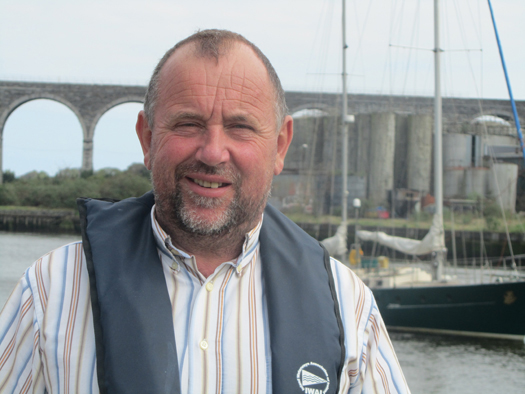
New Rally Commodore Thomas Meegan
Commodore Thomas Meegan explained that this year with over half a century of Inland Waterways boating tradition that we expect an entry of over 100 boats. Thomas outlined that throughout its 50-year history over 2,500 boats and 10,000 people have participated in the boat rally on the Shannon making a substantial economic contribution to the towns and villages along its annual itinerary route.
To mark its 25th year the Rally committee published in 1985 a book called "The Silver River" which documents in detail the early years of the boating event. The follow 25 years were documented with another books to mark the 50th anniversary called "Stories of a River" in 2010.
Thomas is no stranger to the Shannon water having started his boating carer some 23-years ago. His first boat was "Unique Lady" and having experienced a very rough sea trip to the Isle of Man, decided to try the more tranquil waters of the north Shannon. The Shannon won hands down over the rough salt waters off Clogherhead. Thomas with his wife Carmel and family are well know over the length of the river cruising on their boat "Misty Dawn". Thomas is a former Vice-Commodore of the Shannon Boat Rally and in 1998 too line honours when he won the prestigious Premier Award.
"The main objective of the Shannon Boat Rally", explained the Commodore, Thomas "is to bring all types of boaters together to participate in a ten day long fun event for families and friends on the river. "
From its origins in 1961, the rally has grown in popularity every year attracting up to 100 boats annually crewed by over 400 adults, teenagers and children who participate in sports, games, water and boating competitions, quizzes, talent and music events while improving their boating skills and safety practices on our waterways. The rally brings water users of all experiences together to share in a common purpose to enjoy the waterways, to share boating know-how and improve ones boating skills
The rally has attracted many boaters to our inland waterways and promoted development of facilities along the navigation as well as bringing a great dynamic and valuable business to the towns and villages along the river and lakes. The rally also encourages responsible use of the waterways for the benefit of all waterway users and has a strong educational and safety theme throughout.
2011 rally marks the 51st anniversary of the Shannon Boat Rally and it is a very special occasion in the annual IWAI boating calendar. The organising committee are planning a range of rally events and activities to suit all ages.
51st Rally Itinerary
The 51st rally begins on Friday 22nd July and runs until Sunday 31st July. Boats will travel from all locations to arrive in Carrick by Friday evening 22nd for an informal start of the activities.
The following morning, the rally will travel to Drumsna for the official opening.
Following a two night stay in Drumsna, the rally will then travel to Kilglass, Co. Roscommon, followed by Grange, Jamestown and finishing up in Carrick-on-Shannon with a Gala Dinner and prize giving in the Bush Hotel.
For details on the Shannon Boat Rally 2011 click here
Moored in this historic site, from Saturday May 28th to Sunday June 6th 2011, will be the largest gathering of heritage boats in a harbour, since the end of commercial traffic on the Irish inland waterways. On offer throughout the week are events to appeal to everyone in the community.
Over twenty of the Grand Canal Company (GCC) barges together with many other regenerated heritage barges and boats will be on display in the Harbour. Many of these are the old commercial boats that moved large and heavy goods along the canals, rivers and lakes, the motorways of their day. Also in the harbour will be rejuvenated wooden boats, steam tugs, steam yachts, sailing barges and other historic boats.
Each evening in the Crank House starting at 19:30, there will be a different talk on various aspects of the Shannon, her heritage and her historic boats. Entry is free and the public are most welcome.
During the week there will be daily boat trips by Silverline Cruisers with a Birdwatch Ireland Guide on board, to explore the flora and fauna of the River. Newgrange Currach will demonstrate how to build a currach and local teams will compete to build the best one. There are fishing and photographic competitions.
Shannonside Sub Aqua Club's sponsored Fin Swim will be followed by a BBQ open to the public with fun for all the family.
Celebrating the Three Sisters Navigation
This year we celebrate the 220th anniversary of the opening of the Barrow Navigation. This linked the Grand Canal with the rivers Barrow, Nore and Suir, and opened up a large area of the hinterland to the great ports of Dublin and Waterford. When the canals closed to commercial traffic in the 1960s it was feared that all use of the navigation would soon cease. Indeed, non-commercial traffic did become very light, but now, following excellent remedial works by Waterways Ireland we welcome a new era for this navigation, one which will bring new life and vitality to the waterway in the towns and villages along the system.
A hundred years ago, 1,200 boatmen were engaged in the business of transporting cargo, connecting people in inland towns with those in Irish ports, and in turn linking them with the great sea ports of the world. Today, many of their descendants live along our inland navigations.
Three of these great canal boats, numbers 72M, 68M and 107B, escorted by a flotilla of other HBA boats will, over the next few months, travel the entirety of the Navigation including Carlow, Waterford, Carrick on Suir, Inistioge and all points in between. The crews are anxious to meet with those whose families had connections with the commercial trade along the waterway, and perhaps even re-unite some long retired boatmen with their old boat.
The following are the expected arrival dates in various locations over the next few weeks:
° Carlow April 9th from 14.00
° Leighlinbridge April 16th from 14.00
° Bagenalstown April 24th from 13.00
Navigable Channel in Shannon Harbour Now Open
Inland waterways Marine Notice No. 27 of 2011 Waterways Ireland advises masters and users that the navigable channel in Shannon Harbour on the Grand Canal is now open. The new house boat facility remains closed to the public as construction work continues.
Click this link for the latest boating news on Ireland's Inland Waterways




























